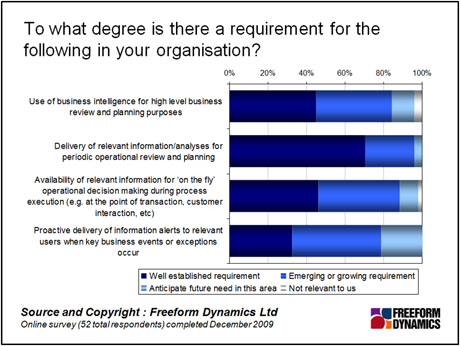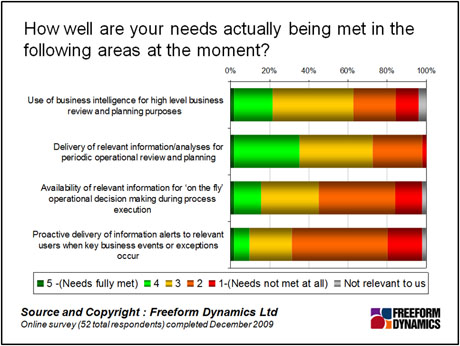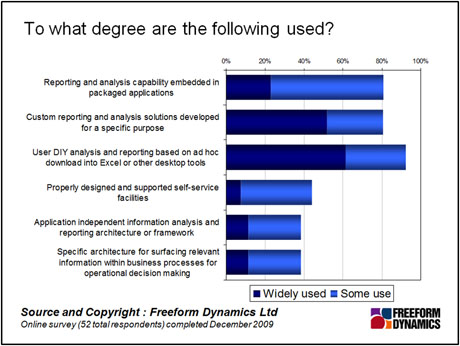Consultants and analysts often trot out lines about the importance of ‘IT-business alignment’, encouraging IT departments to tune into the ‘business agenda’ and take their lead from management priorities and objectives. But what happens when management and the broader business needs help with something, only to have a blind spot when it comes to recognising the requirement and supporting the action necessary to deal with it?
A huge example of this has emerged in various different ways over the past few weeks as part of our online workshop on business applications. The first clue came when a poll told us that making better use of the information held in ERP and CRM applications was the most obvious way of unlocking more value from these systems. When looking at what we should expect from business application suppliers over the coming decade, we then saw quite a strong emerging need for integrated business intelligence capability.
But when we broadened the discussion, and ran another poll looking at the way in which information needs are evolving and being dealt with in a more general sense, we started to get a real appreciation of not only the gap that often exists between business requirements and IT capability, but also the frustration felt by IT professionals who understand the problem, and even have ideas on how to solve it, but are just not given the mandate and resources to deal with the challenge effectively.
So let’s walk through it step by step.
Firstly, there can be little doubt about the hunger for timely and accurate information within the business at various different levels, and the fact that this is increasing, particularly with regard to strategic business review and planning at one end, and dealing with more immediate information needs in the ongoing process/operational context at the other (Figure 1).

Figure 1
The last bar on this chart also highlights growing interest in ‘push’ delivery models in which users are alerted to relevant information as key business events and exceptions occur, which goes hand in hand with the more operational requirement and the notion of using information to steer the business on more of a real time basis.
All of this makes perfect sense, but here’s where it starts to fall to pieces. If we look at how well the above needs are being met at the moment, it’s not a pretty picture (Figure 2).

Figure 2
The negligible number of respondents saying needs are fully met in any category is quite telling, but so too are the big gaps around both high-level planning and operational decision support.
The reason for these gaps becomes clear when we look at the information management and access mechanisms in use. The strong dependency on point solutions and user DIY, with relatively little attention paid to architecture and the adoption of a more joined up approach, is a recipe for fragmentation and inconsistency (Figure 3).

Figure 3
So is this a clear case of IT negligence or incompetence?
Well, no, and this is very obvious when we consider feedback from readers. IT professionals are aware that taking a more infrastructural/architectural approach will help with the problems of fragmentation and inconsistency, as well as providing a foundation for proper self service facilities to wean users off their DIY habit. When asked where the emphasis was being placed in terms of information delivery and access improvements looking forward, for example, some pretty clear messages come through, as illustrated by these reader quotes:
Self help access to quick indicators – dashboards – with drill down capability
Emphasis on operations MI
Frontline staff having direct access to information and reporting
Improvements to data warehouse interoperability and projects designed to manage the mapping data needed to profile the raw data
The emphasis is on standardising data formats and using open systems and architecture.
But years of taking a piecemeal approach and perpetuating the problem of information silos has so often led to a degree of complacency among business management, who have grown accustomed to the issues and limitations, accept them as ‘normal’, and therefore never get around to prioritising them being addressed, despite the IT counselling that is clearly taking place. From an IT department perspective, it’s therefore less about knowing what to do and more about being allowed to do it. The frustration of this comes through loud and clear in comments such as:
The blind leading the visually impaired around here, can’t see anything meaningful happening in the short, medium or long term.
Too many independent systems (and organizations) that either can’t or won’t talk to each other. (The former being technical, the latter generally being political.)
I expect further chaos and ad-hockery.
Nevertheless, some in IT, hard though it is, are beginning to make headway:
The whole is often greater than the sum of the parts – but only if it can be aggregated appropriately. My company is [finally] investing a lot of resources to resolve this issue.
We’re overhauling our infrastructure to be more flexible to cope with new requirements. We have a large volume of legacy applications which need to be brought in line with unified management/reporting.
Killing silos and fragmentation, growing data warehouses and marts, integrated reporting above the app level, culture change around the whole info delivery perspective.
The reference to cultural change in this last comment is very profound, as many businesses suffer from parochialism within the ranks of their middle management. This isn’t just to do with information management and access; we see it getting in the way of progress in many other areas too, from attempts to build more coherent operational capability, through to initiatives to exploit dynamic virtual infrastructure in the data centre. Getting people to think about the business as a whole, rather than their small part of it, is a constant challenge.
When it comes to the information side of things, however, if pulling off cultural change through logical argument, persuasion and smooth talk isn’t working, you can always try the more pragmatic approach:
Emphasis initially on making information widely available, and then when they realise their data is horrible, improving it.
If ever there was a case for injecting a bit of IT governance into the mix based on an objective discussion and understanding between the IT department and business stakeholders, then dealing with the information gap is probably it.